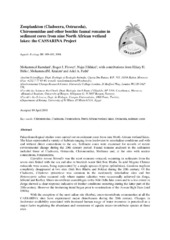| dc.contributor.author | Ramdani, Mohammed | eng |
| dc.contributor.author | Flower, Roger J. | eng |
| dc.contributor.author | Elkhiati, Najat | eng |
| dc.contributor.author | Birks, Hilary H. | eng |
| dc.contributor.author | Kraïem, Mohammed M. | eng |
| dc.contributor.author | Fathi, Adel A. | eng |
| dc.date.accessioned | 2007-12-20T10:21:22Z | |
| dc.date.available | 2007-12-20T10:21:22Z | |
| dc.date.issued | 2001 | eng |
| dc.Published | Aquatic Ecology 2001 35 (3/4): 389-403 | en |
| dc.identifier.issn | 1386-2588 | en_US |
| dc.identifier.uri | https://hdl.handle.net/1956/2516 | |
| dc.description.abstract | Palaeolimnological studies were carried out on sediment cores from nine North African wetland lakes. The lakes represented a variety of habitats ranging from freshwater to mixohaline conditions and with and without direct connections to the sea. Sediment cores were examined for records of recent environmental change during the 20th century period. Faunal remains analysed in the sediments included those of Cladocera, Ostracoda, Chironomidae, Mollusca and, at the sites with marine connections, Foraminifera. Cyprideis torosa littoralis was the most common ostracod, occurring in sediments from the seven sites linked with the sea and also in brackish water Sidi Bou Rhaba. In acid Megene Chitane ostracods were scarce, being represented by a single species (Cypria ophtalmica). Candona neglecta completely disappeared at two sites (Sidi Bou Rhaba and Bokka) during the 20th century. Of the Cladocera, Chydorus sphaericus was common in the moderately mixohaline sites and but Heterocypris salina occurred only where marine salinities were occasionally achieved (in Zerga, Ichkeul and Korba). Microinvertebrate assemblages in the Nile Delta lake cores and to a less extent in Zerga showed a clear response indicative of more fresher conditions occurring during the latter part of the 20th century. However the freshening trend began prior to construction of the Aswan High Dam (mid 1960s). With the exception of the most saline site (Korba), microinvertebrate communiuties at all the CASSARINA sites have experienced major disturbances during the 20th century. Changes in freshwater availability associated with increased human usage of water resources is perceived as a major factor regulating the abundance and occurrence of aquatic microinvertebrate species at these sites. | en_US |
| dc.language.iso | eng | eng |
| dc.publisher | Springer | en_US |
| dc.subject | Chironomidae | eng |
| dc.subject | Cladocera | eng |
| dc.subject | Foraminifera | eng |
| dc.subject | North African wetland lakes | eng |
| dc.subject | Ostracoda | eng |
| dc.subject | sediment cores | eng |
| dc.title | Zooplankton (Cladocera, Ostracoda), Chironomidae and other benthic faunal remains in sediment cores from nine North African wetland lakes: the CASSARINA Project | en_US |
| dc.type | Peer reviewed | |
| dc.type | Journal article | |
| dc.identifier.doi | https://doi.org/10.1023/a:1011965226399 | |
| dc.subject.nsi | VDP::Matematikk og Naturvitenskap: 400::Zoologiske og botaniske fag: 480 | nob |
